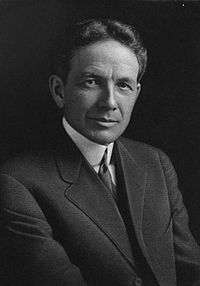De Vaux
The De Vaux (da voe) was an automobile produced by the De Vaux-Hall Motors Company of Grand Rapids, Michigan, and Oakland, California.
Heavily based on the 1930 Durant (Norman de vaux was a former Durant executive), production began with the 1931 model year. Bodies for the cars were built by Hayes Body of Grand Rapids, which had leased a plant next to its own to De Vaux for initial manufacture.[1] Bodies were delivered to De Vaux by using a bridge between the plants. Later, a smaller number of De Vaux cars were built in a former Durant plant in Oakland, California.
The cars were powered by a six-cylinder L-head engine designed by Col. Elbert J. Hall, a partner in the venture, and built by the Continental Motors Company of Muskegon, Michigan.[1] The De Vaux engine was a modified Continental 22-A engine, most of the changes being made to the block, manifolds, and carburetor, and it developed 70 or 80 hp (52 or 60 kW; 71 or 81 PS) (sources differ).
The De Vaux was offered in one model only, the 6/75, and rode on a 113 in (2,900 mm) wheelbase. Bodies were essentially the same as the defunct Durant, but got a minor facelift from Russian-born stylist Alexis de Sakhnoffsky. Sakhnoffsky designed for other automakers including Cord, Auburn, Nash, Packard, and American Bantam. The company frequently mentioned the "de Sakhnoffsky styled" body in its ads. Offered were a Coupe and a Sedan in Standard trim or Custom trim, priced at $595 and $795, respectively.[1] A $545 Phaeton is occasionally mentioned, but it did not reach production and De Vaux neither advertised nor sold it.
Production began in Grand Rapids on April 1, 1931, and the company claimed to have over 8,000 orders in hand. Firm orders were far fewer, so production at the two plants was reduced. Oakland was second of the two plants to begin production and the first to close. De Vaux-Hall filed for bankruptcy in February 1932,[1] unable to pay its creditors (including Continental). De Vaux produced 4,808 vehicles (maybe including production until January, 1932). Days after De Vaux-Hall announced its bankruptcy, Continental Motors Corporation announced it would buy the Michigan assets of De Vaux-Hall; De Vaux-Hall owed the engine maker nearly a half million dollars.[1] The new owner renamed the company Continental-De Vaux Company. Their cars were then called Continental De Vaux (sometimes vice versa). There were few changes and only 1,358 were built (sources differ).
Continental came out in the 1933 model year with their own cars, not based on the Durant/De Vaux cars. It renamed the company Continental Automobile Company in November 1932. It built three models: the 4-cylinder Beacon, on a shorter chassis, and the 6-cylinder Ace and Flyer, both based on the De Vaux. For 1934, only the Beacon remained, renamed the Red Seal Four. After producing approximately 4,200 vehicles during the 1933 and 1934 model years, Continental gave up. Remaining assets were repurchased by Norman De Vaux who hoped to restart production. His plans never materialized and he sold his California plant to General Motors in 1936.[1]
See also
Sources
- Bradford, Francis and Ric Dias, "Hall-Scott: the Untold Story of a Great American Engine Maker," SAE Int'l, 2007 ISBN 978-0-7680-1660-4
- Dias, Ric, "E.J. Hall's Life of Power," Automobile Quarterly, 48, First Quarter 2008, 62-75
